E/E Architecture Research: How will the zonal EEA evolve and materialize from the perspective of supply chain deployment?
Through the lens of development trends, automotive EEA (Electronic/electrical Architecture) will eventually evolve to central computing architectures with functional logics centralized in one central controller. OEMs become ever more radical in EEA planning. For OEMs, the year of 2023- 2023 will be a key time node to mass-produce the next-generation “quasi-central computing + zone” architecture.
Evolution Trends of Automotive E/E Architecture in the Next 5- 10 Years
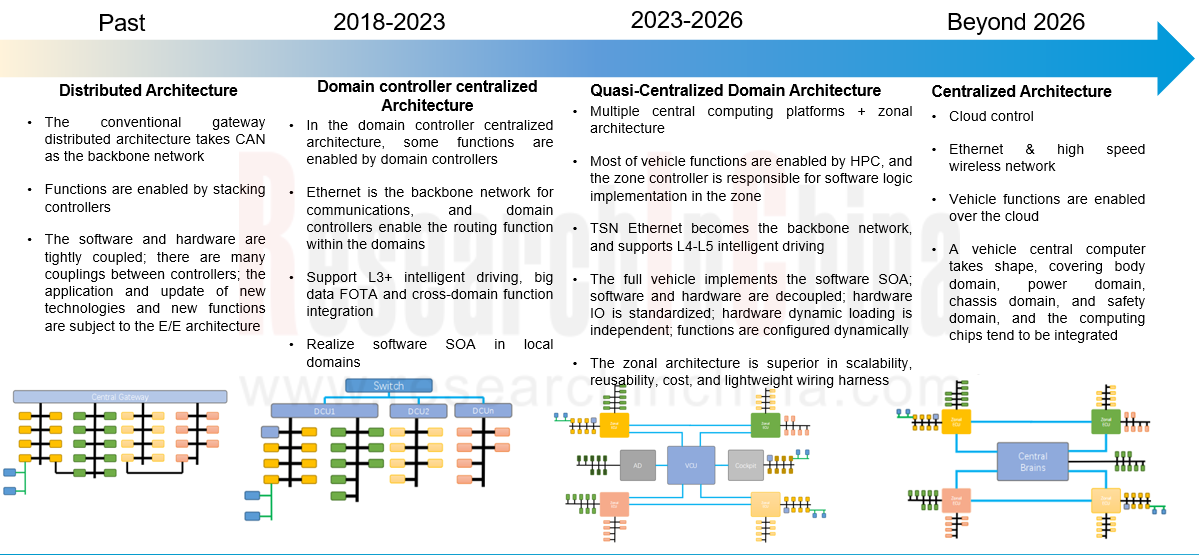
Source: ResearchInChina
The “quasi-central computing + zone” architecture can be further subdivided into many types:
 Body-zonal architecture: The controller of the body zone is connected to the central computing unit through the high-speed Ethernet backbone network, and the central computing unit integrates the functions like vehicle control, body control and gateways, simplifying the network topology, wiring harness layout and weight;
Body-zonal architecture: The controller of the body zone is connected to the central computing unit through the high-speed Ethernet backbone network, and the central computing unit integrates the functions like vehicle control, body control and gateways, simplifying the network topology, wiring harness layout and weight;
 X-domain zonal architecture: The functional zone is combined with the body zone, and the X-domain uses a more powerful processor unit, which can independently call the sensors in the zone and process data;
X-domain zonal architecture: The functional zone is combined with the body zone, and the X-domain uses a more powerful processor unit, which can independently call the sensors in the zone and process data;
 Software-defined vehicle (SDV) optimized architecture: With centralized and service-oriented computing, the central computer of vehicle has powerful processing capability and makes all decisions, while zonal controllers supply power and perform the instructions issued by the central control unit.
Software-defined vehicle (SDV) optimized architecture: With centralized and service-oriented computing, the central computer of vehicle has powerful processing capability and makes all decisions, while zonal controllers supply power and perform the instructions issued by the central control unit.
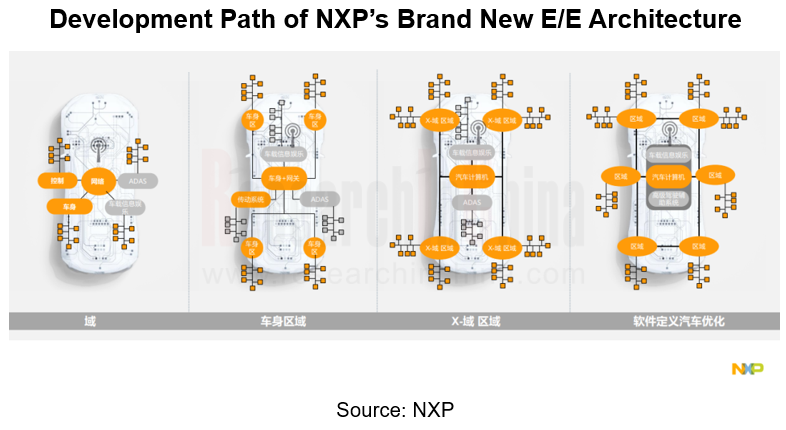
Under zonal architecture, MCUs tend to feature high performance and multi-core
In the future central integrated E/E architecture, the central processing unit communicates with zonal controllers through Ethernet, while zonal controllers communicate with sub-ECUs, sensors and actuators through CAN/LIN bus.
Physically, the zonal controllers logically concentrate multiple ECUs, proposing a higher requirement for the computing power of MCU in the zonal controllers. In the traditional ECUs with simple functions, a single-core MCUs with low performance are qualified, while zonal controllers often require multi-core MCUs. In a multi-core MCU, each core can run a single function, while multi-core can realize multiple functions, thus realizing the integration of multiple ECU functions.
 X-Soul Architecture of GAC Aion GA3.0
X-Soul Architecture of GAC Aion GA3.0
The newly-launched Hyper GT is the world's first model that uses NXP S32G3 as the central computing unit processor. The "central computing unit" developed by Continental adopts the latest "NXP S32G399 high-performance gateway computing chip". The basic middle layer of the software architecture of the front and rear zonal controllers adopts atomic service packaging and standardized interfaces, and the middle layer uses enhanced composite services and can be implemented independently.
 Xpeng’s X-EEA3.0
Xpeng’s X-EEA3.0
For the first time in China, it has attained a communication architecture with Gigabit Ethernet as the backbone and supports multiple communication protocols, making vehicle data transmission faster. The central computing unit and zonal controllers of X-EEA3.0 adopt Renesas’ flagship MCU based on the third-generation RXv3 CPU core. On the basis of X-EEA3.0, Xpeng G6 has further mass-produced and deployed the new Fuyao X-EEA3.5.
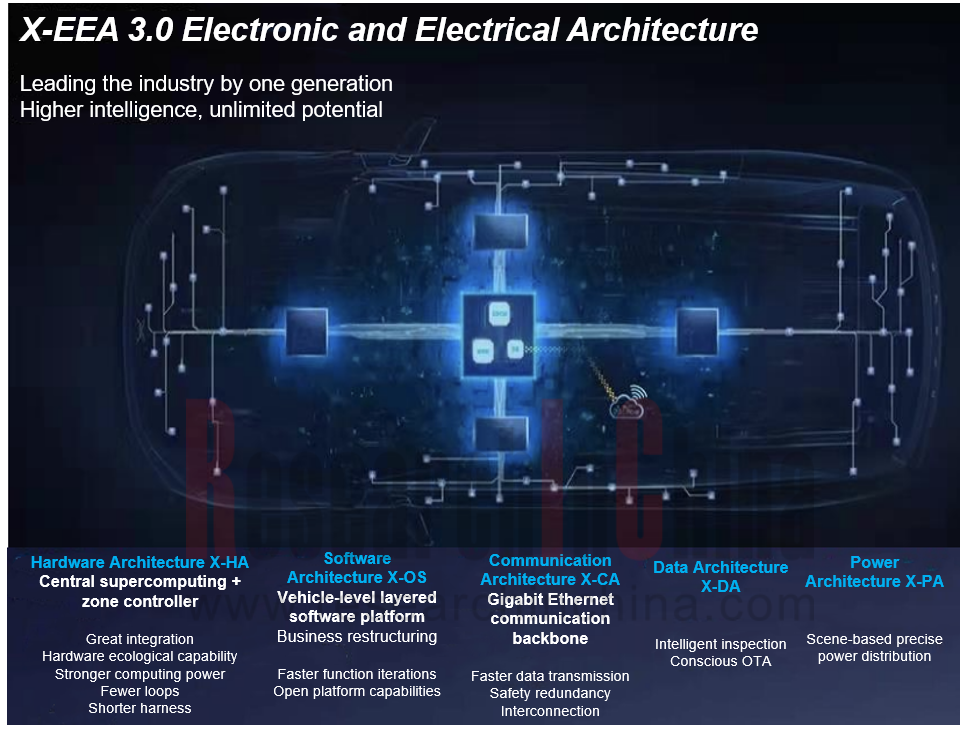
Source: Xpeng
 Infineon's 3rd-generation AURIX? TC4xx MCU
Infineon's 3rd-generation AURIX? TC4xx MCU
High-performance AURIX? TC4xx family mainly meets the new requirements of the central computing and zonal control. It is equipped with up to six TriCore? 1.8 embedded cores, each with a clock frequency of up to 500MHz; integrated with a PPU coprocessor, it can realize fast vector operation, basic neural network algorithms and other complex mathematical algorithms. In future regional controllers, PPU can be used in some information security algorithms for modeling, model predictive control, and anti-intrusion detection.

Under zonal architecture, the demand for automotive Ethernet PHY and switch chips soars, so that the price fluctuates sharply.
The interface circuit of automotive Ethernet is mainly composed of MAC controllers and PHY chips. In terms of integration method, embedded chip vendors generally integrate the MAC inside the MCU/CPU. For example, Infineon's AURIX integrates MAC into the main MCU, and also integrates CRE/DRE, the dedicated hardware communication routing module; whereas, the PHY chip is provided by the OEM or controller supplier as an independent chip.
The global Ethernet switch/PHY chip market size hit about USD800 million in 2023, and it is expected to reach USD2.5 billion in 2028. It is estimated that each car will use 2-4 Ethernet switch chips and 2-4 PHY chips on average by 2028.
Since 2023, the short-term price of some Ethernet PHY and switch chips of Broadcom BCM89 family has soared several times, with a single chip valued USD30-40. The BCM8955X family is Broadcom's third-generation automotive Ethernet switch solutions, which are mainly used in ADAS, infotainment systems and gateways. At present, Broadcom mainly promotes the BCM8957X family, which is the only automotive Ethernet switch in the world that supports the 802.3ch standard.
In a typical central computing + zonal architecture, each zonal gateway contains an Ethernet switch, and each vehicle requires at least 6-7 Ethernet switch chips. At present, Marvell, Broadcom, NXP and other automotive network communication chip vendors have proposed the next-generation network architecture.
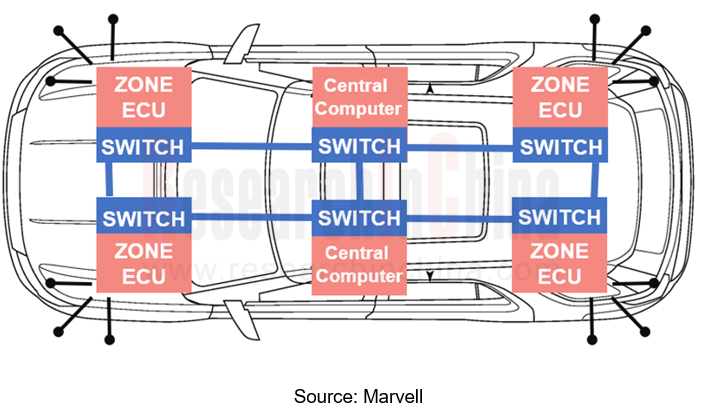
OEMs forecast that the central computing + zonal architecture will only come true in 2025 by virtue of 10G bandwidth. In June 2023, Marvell announced the Brightlane Q622x family of central Automotive Ethernet switches to support the zonal networking architectures of next-generation vehicles. Central Automotive Ethernet switches are high-bandwidth, high-performance devices optimized to coordinate data traffic between zonal switches, which aggregate traffic from devices located within a physical zone of a car like processors, sensors, actuators, storage systems and others.
In the 10 Gigabit automotive Ethernet chip market, only Marvell and Broadcom can provide 10G+ Ethernet switches.
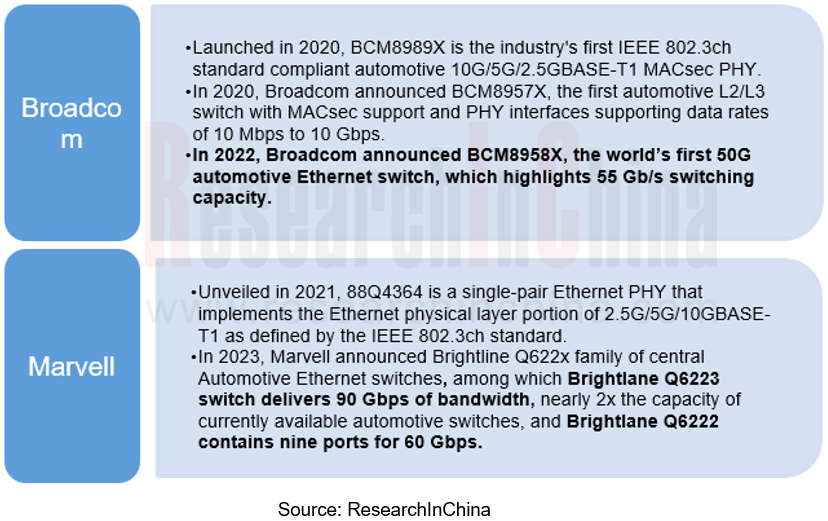
Under zonal architecture, the on-chip high-speed communication of central computer requires PCIe switches.
Driven by Chat GPT, the demand for AI servers has skyrocketed, and PCIe Switch chips represented by Broadcom SS26 are in shortage with the price swelling. In the next-generation E/E architecture, expensive PCIe switches are required by connection between multi-SoC cascade, SSD storage based on PCIe and the central SoC.

The cross-domain communication of automobiles will be based on PCIe, which can improve the communication efficiency to dozens of gigabytes compared with the previous Ethernet, and PCIe Switch enables the on-chip communication. Ethernet Switches are mounted on different SoCs in the central computing unit. The external sensors are connected in series through the Ethernet switches of zonal ECUs.
 Qualcomm's first-generation autonomous driving system, Ride3.0, uses PCIe switches in the automotive industry for the first time, that is, Microchip's PM43028B1-F3EI priced at about $100 dollars, higher than that of SA8155P and almost 4-5 times that of Ethernet switches.
Qualcomm's first-generation autonomous driving system, Ride3.0, uses PCIe switches in the automotive industry for the first time, that is, Microchip's PM43028B1-F3EI priced at about $100 dollars, higher than that of SA8155P and almost 4-5 times that of Ethernet switches.
 Visteon’s dual Qualcomm 8155 cockpit domain controllers are internally connected via the PCIe bus. Two 8155 SoCs are connected through PCle bus, with the transmission rate of 16Gbps, which can efficiently transmit the real-time video input of ADAS.
Visteon’s dual Qualcomm 8155 cockpit domain controllers are internally connected via the PCIe bus. Two 8155 SoCs are connected through PCle bus, with the transmission rate of 16Gbps, which can efficiently transmit the real-time video input of ADAS.
 SiEngine Technology has customized the high-speed interconnection bus SE-LINK for ECARX to realize the simultaneous operation of two "Longying No.1" chips. Two Antora 1000 platforms are connected to get Antora 1000 Pro. It can provide double computing power while maintaining the transmission speed, wherein the transmission speed of PCIe 3.0 Lane reaches 7.28 GT/s.
SiEngine Technology has customized the high-speed interconnection bus SE-LINK for ECARX to realize the simultaneous operation of two "Longying No.1" chips. Two Antora 1000 platforms are connected to get Antora 1000 Pro. It can provide double computing power while maintaining the transmission speed, wherein the transmission speed of PCIe 3.0 Lane reaches 7.28 GT/s.
EEA evolution drives the upheaval of underlying OS of vehicle
Adaptive AUTOSAR introduces the service-oriented architecture (SOA) and support for POSIX system, suitable for high-computing SoCs. SOA or the service-based middleware platform is also known as the automotive OS.
 The SOA of GAC's X-Soul architecture has realized standardized layered interfaces, software modularization, function atomization, remote function configuration and so on through the layered decoupled basic software architecture platform. GAC's X-Soul architecture is China's first product developed based on the ASF (AUTOSEMO Service Framework) technical specification. On the basis of the SOA, the GAC Rubik's Cube scenario co-creation platform has been mass-produced with GAC Aion Hyper GT.
The SOA of GAC's X-Soul architecture has realized standardized layered interfaces, software modularization, function atomization, remote function configuration and so on through the layered decoupled basic software architecture platform. GAC's X-Soul architecture is China's first product developed based on the ASF (AUTOSEMO Service Framework) technical specification. On the basis of the SOA, the GAC Rubik's Cube scenario co-creation platform has been mass-produced with GAC Aion Hyper GT.
 In April 2023, Huawei released the iDVP intelligent digital base, which is a SOA that allows zonal access and central computing. iDVP includes a hardware platform and a software platform. The hardware platform refers to the basic hardware platform of the computing and communication architecture, and the software platform includes an operating system, a basic management framework and a SOA software framework. In order to facilitate users to develop software on iDVP, Huawei has developed a supporting tool chain.
In April 2023, Huawei released the iDVP intelligent digital base, which is a SOA that allows zonal access and central computing. iDVP includes a hardware platform and a software platform. The hardware platform refers to the basic hardware platform of the computing and communication architecture, and the software platform includes an operating system, a basic management framework and a SOA software framework. In order to facilitate users to develop software on iDVP, Huawei has developed a supporting tool chain.
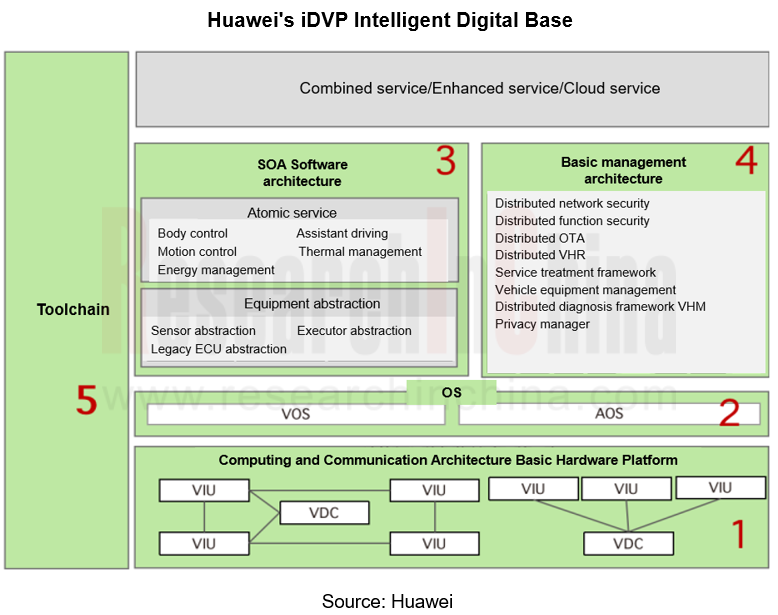
Autonomous Driving Domain Controller and Central Computing Unit (CCU) Industry Report, 2025
Research on Autonomous Driving Domain Controllers: Monthly Penetration Rate Exceeded 30% for the First Time, and 700T+ Ultrahigh-compute Domain Controller Products Are Rapidly Installed in Vehicles
L...
China Automotive Lighting and Ambient Lighting System Research Report, 2025
Automotive Lighting System Research: In 2025H1, Autonomous Driving System (ADS) Marker Lamps Saw an 11-Fold Year-on-Year Growth and the Installation Rate of Automotive LED Lighting Approached 90...
Ecological Domain and Automotive Hardware Expansion Research Report, 2025
ResearchInChina has released the Ecological Domain and Automotive Hardware Expansion Research Report, 2025, which delves into the application of various automotive extended hardware, supplier ecologic...
Automotive Seating Innovation Technology Trend Research Report, 2025
Automotive Seating Research: With Popularization of Comfort Functions, How to Properly "Stack Functions" for Seating?
This report studies the status quo of seating technologies and functions in aspe...
Research Report on Chinese Suppliers’ Overseas Layout of Intelligent Driving, 2025
Research on Overseas Layout of Intelligent Driving: There Are Multiple Challenges in Overseas Layout, and Light-Asset Cooperation with Foreign Suppliers Emerges as the Optimal Solution at Present
20...
High-Voltage Power Supply in New Energy Vehicle (BMS, BDU, Relay, Integrated Battery Box) Research Report, 2025
The high-voltage power supply system is a core component of new energy vehicles. The battery pack serves as the central energy source, with the capacity of power battery affecting the vehicle's range,...
Automotive Radio Frequency System-on-Chip (RF SoC) and Module Research Report, 2025
Automotive RF SoC Research: The Pace of Introducing "Nerve Endings" such as UWB, NTN Satellite Communication, NearLink, and WIFI into Intelligent Vehicles Quickens
RF SoC (Radio Frequency Syst...
Automotive Power Management ICs and Signal Chain Chips Industry Research Report, 2025
Analog chips are used to process continuous analog signals from the natural world, such as light, sound, electricity/magnetism, position/speed/acceleration, and temperature. They are mainly composed o...
Global and China Electronic Rearview Mirror Industry Report, 2025
Based on the installation location, electronic rearview mirrors can be divided into electronic interior rearview mirrors (i.e., streaming media rearview mirrors) and electronic exterior rearview mirro...
Intelligent Cockpit Tier 1 Supplier Research Report, 2025 (Chinese Companies)
Intelligent Cockpit Tier1 Suppliers Research: Emerging AI Cockpit Products Fuel Layout of Full-Scenario Cockpit Ecosystem
This report mainly analyzes the current layout, innovative products, and deve...
Next-generation Central and Zonal Communication Network Topology and Chip Industry Research Report, 2025
The automotive E/E architecture is evolving towards a "central computing + zonal control" architecture, where the central computing platform is responsible for high-computing-power tasks, and zonal co...
Vehicle-road-cloud Integration and C-V2X Industry Research Report, 2025
Vehicle-side C-V2X Application Scenarios: Transition from R16 to R17, Providing a Communication Base for High-level Autonomous Driving, with the C-V2X On-board Explosion Period Approaching
In 2024, t...
Intelligent Cockpit Patent Analysis Report, 2025
Patent Trend: Three Major Directions of Intelligent Cockpits in 2025
This report explores the development trends of cutting-edge intelligent cockpits from the perspective of patents. The research sco...
Smart Car Information Security (Cybersecurity and Data Security) Research Report, 2025
Research on Automotive Information Security: AI Fusion Intelligent Protection and Ecological Collaboration Ensure Cybersecurity and Data Security
At present, what are the security risks faced by inte...
New Energy Vehicle 800-1000V High-Voltage Architecture and Supply Chain Research Report, 2025
Research on 800-1000V Architecture: to be installed in over 7 million vehicles in 2030, marking the arrival of the era of full-domain high voltage and megawatt supercharging.
In 2025, the 800-1000V h...
Foreign Tier 1 ADAS Suppliers Industry Research Report 2025
Research on Overseas Tier 1 ADAS Suppliers: Three Paths for Foreign Enterprises to Transfer to NOA
Foreign Tier 1 ADAS suppliers are obviously lagging behind in the field of NOA.
In 2024, Aptiv (2.6...
VLA Large Model Applications in Automotive and Robotics Research Report, 2025
ResearchInChina releases "VLA Large Model Applications in Automotive and Robotics Research Report, 2025": The report summarizes and analyzes the technical origin, development stages, application cases...
OEMs’ Next-generation In-vehicle Infotainment (IVI) System Trends Report, 2025
ResearchInChina releases the "OEMs’ Next-generation In-vehicle Infotainment (IVI) System Trends Report, 2025", which sorts out iterative development context of mainstream automakers in terms of infota...